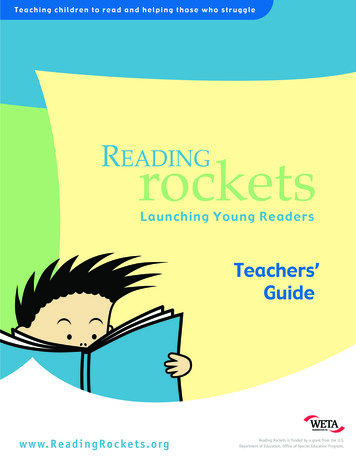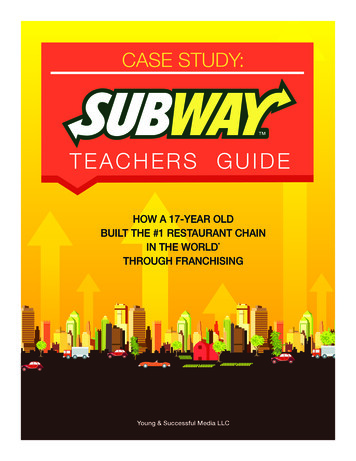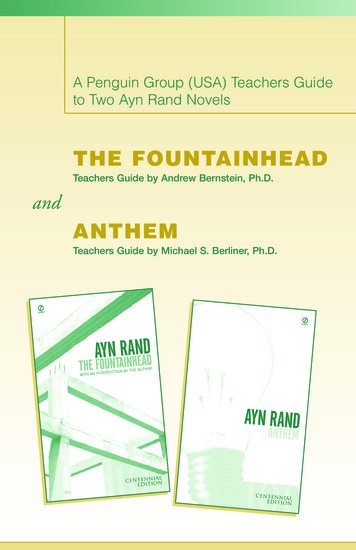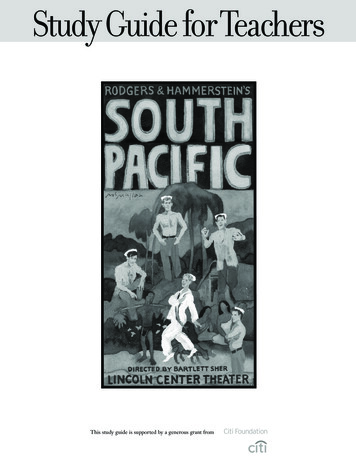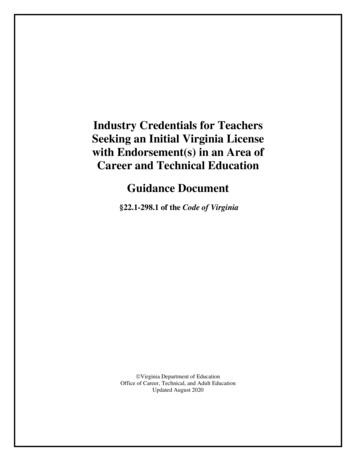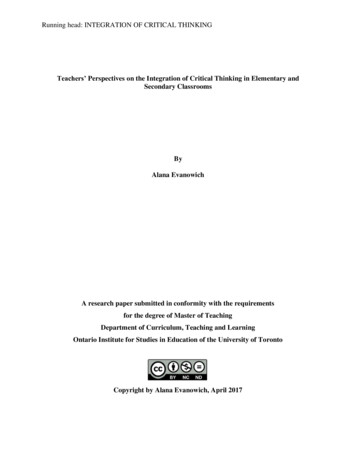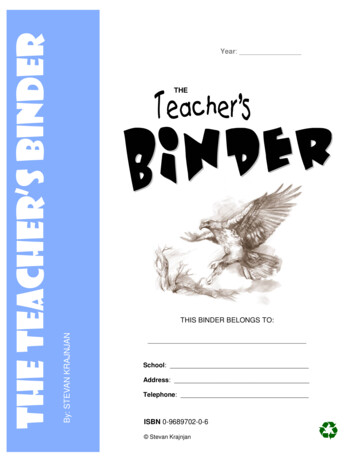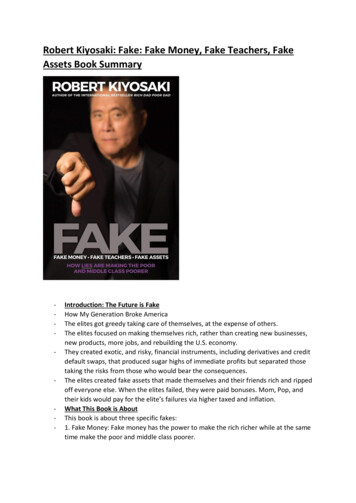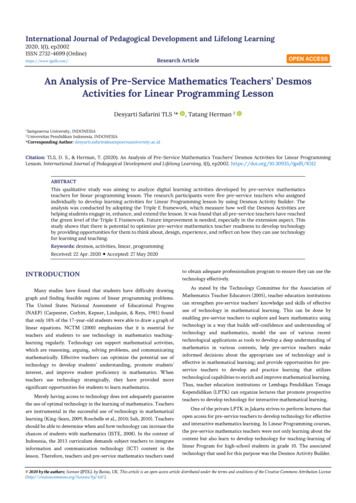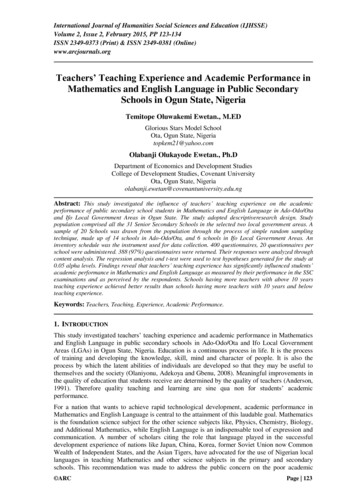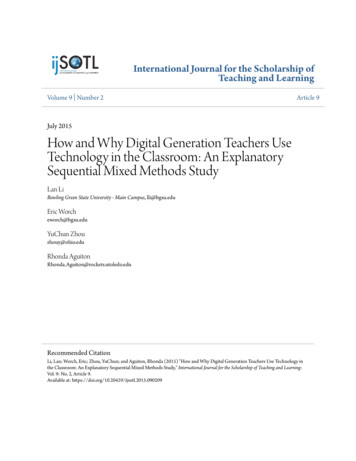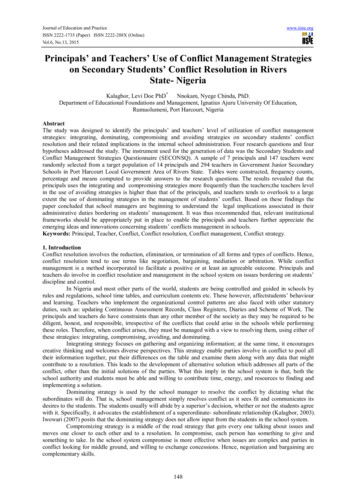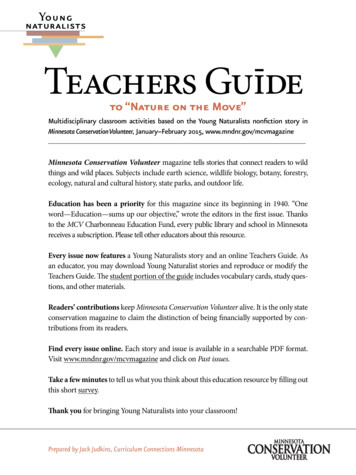
Transcription
Youngnaturalists Teachers Guīdeto “Nature on the Move”Multidisciplinary classroom activities based on the Young Naturalists nonfiction story inMinnesota Conservation Volunteer, January–February 2015, www.mndnr.gov/mcvmagazineMinnesota Conservation Volunteer magazine tells stories that connect readers to wildthings and wild places. Subjects include earth science, wildlife biology, botany, forestry,ecology, natural and cultural history, state parks, and outdoor life.Education has been a priority for this magazine since its beginning in 1940. “Oneword—Education—sums up our objective,” wrote the editors in the first issue. Thanksto the MCV Charbonneau Education Fund, every public library and school in Minnesotareceives a subscription. Please tell other educators about this resource.Every issue now features a Young Naturalists story and an online Teachers Guide. Asan educator, you may download Young Naturalist stories and reproduce or modify theTeachers Guide. The student portion of the guide includes vocabulary cards, study questions, and other materials.Readers’ contributions keep Minnesota Conservation Volunteer alive. It is the only stateconservation magazine to claim the distinction of being financially supported by contributions from its readers.Find every issue online. Each story and issue is available in a searchable PDF format.Visit www.mndnr.gov/mcvmagazine and click on Past issues.Take a few minutes to tell us what you think about this education resource by filling outthis short survey.Thank you for bringing Young Naturalists into your classroom!Prepared by Jack Judkins, Curriculum Connections Minnesota
“Nature on the Move”Multidisciplinary classroom activities based on the Young Naturalists nonfiction story inMinnesota Conservation Volunteer, January–February 2015, www.mndnr.gov/mcvmagazineSummary. “Nature on the Move” gives young readers a brief introduction to climatescience. Students learn how current climate change is different from past climate changes,how it is likely to affect Minnesota’s plants and animals, and what can be done to slow thebuild up of greenhouse gases in our atmosphere. Note: This article connects well with manyeighth grade earth and space science standards.Suggested reading levels. Third through middle school gradesMaterials. KWL organizer, paper, poster board, colored pencils, crayons, pens, mark-ers, NASA online climate trivia game (http://climatekids.nasa.gov/trivia/), print and onlineresources your media specialist may providePreparation time. One to two hours, not including time for extension activitiesEstimated instruction time. One or two 50-minute class periods (not including extensions)Minnesota academic standards applications. “Nature on the Move”may be applied to the following Minnesota Department of Education standards:Language Arts Reading Benchmarks Informational Text 3–8. Key Ideasand Details, Craft and Structure, Integration of Knowledge and Ideas, Range of Reading,and Level of Text Complexity
Writing Benchmarks 3–8. Text Types and Purposes, Writing Process, Research toBuild and Present Knowledge, Range of WritingReading Benchmarks: Literacy in in Science and Technical Subjects6–12. Key Ideas and Details, Craft and Structure, Integration of Knowledge and Ideas,Range of Reading, and Level of Text ComplexityWriting Benchmarks: Literacy in History/Social Studies, Scienceand Technical Subjects 6–12. Text Types and Purposes, Writing Process:Production and Distribution of Writing Research to Build and Present Knowledge, Rangeof WritingScience Grades 3, 5, 6, 7, 8 and high schoolThe Nature of Science and Engineering5.1.1.1.1; 5.1.1.1.2; 5.1.1.1.3; 5.1.1.1.4; 5.1.3.4.1; 5.1.3.4.2; 7.1.1.2.1; 7.1.1.2.4; 7.1.3.4.1;8.1.1.1.1; 8.1.1.2.1; 8.1.3.4.1Interactions Among Science, Technology, Engineering, Mathematics, and Society3.1.2.2.1; 3.1.3.2.2; 3.1.3.4.1Earth and Space Science4.3.2.3.1; 5.3.1.2.1; 5.3.1.2.2; 5.3.4.1.1; 5.3.4.1.2; 5.3.4.1.3; 8.3.1.3.1; 8.3.2.1.1; 8.3.2.1.2;8.3.2.1.3; 8.3.2.2.1; 8.3.2.2.2; 8.3.2.2.3; 8.3.4.1.1Life Science5.4.1.1.1; 5.4.2.1.2; 5.4.4.1.1; 7.4.2.1.3; 7.4.2.2.1; 7.4.3.2.1; 7.4.3.2.3; 7.4.3.2.4; 7.4.4.1.2Social Studies Grades 3, 5, 6, 7, 8 and high schoolGeography4.3.1.2.1; 4.3.2.3.1; 4.3.3.6.1; 4.3.4.9.1; 5.3.4.10.1; 8.3.1.1.1; 8.3.1.2.1; 8.3.3.6.1Arts Grades K–12.1. Artistic Foundations: Visual Arts2. Artistic Process: Create or Make: Visual Arts3. Artistic Process: Perform or Present: Visual Arts4. Artistic Process: Respond or Critique: Visual ArtsCurrent, complete Minnesota Academic Standards are available at www.education.state.mn.us. Teachers who find other connections to standards are encouraged to contactMinnesota Conservation Volunteer.
Preview. (1) See the NASA climate trivia game at http://climatekids.nasa.gov/trivia/, aneight-question quiz that you can do with your class or that your students can do individuallyif they have laptops or tablets. The quiz should prompt questions that heighten interest in thearticle. (2) Instead of (or in addition to) the climate quiz, you may do a KWL (Ogle, 1986)activity. To find out what your students already know (K), divide the class into small groupsand have each group brainstorm ideas about climate and climate change. Give each student acopy of the organizer (see www.teach-nology.com/web tools/graphic org/kwl) and encourage each to make notes during the small group discussion. Post their ideas on a flip chart orposter board. Repeat step one by asking students what they would like to learn about climateand climate change (W). As with (K), post for future reference. As you read and discuss thearticle you will begin to compile the (L) list, or what they learn while reading the article andrelated materials and participating in extension activities. KWL gives you the opportunity tointroduce interdisciplinary connections you will make during extension activities. If you usethe article in science, social studies, or art class, you may wish to focus your pre-reading activity on academic standards that apply for that class. (3) See www.teachervision.fen.com/ tv/printables/TCR/0743932080 007.pdf for a brainstorming web download.Vocabulary preview. See the copy-ready vocabulary list included in this guide. Youmay wish to modify the list based on your knowledge of your students’ needs or the subjectyou are teaching. Pretesting vocabulary individually, in small groups, or with your entireclass can be an effective vocabulary preview strategy. You may then post-test at the conclusion of this activity (see Assessment section below). Italicized words are not generallyincluded on the list or in the study cards.You may wish to use the study cards found at the end of this guide. Cut along the horizontal line; fold in the middle, and tape or staple. Study cards (see Strategic Tutoring,Hock, Deshler, and Schumaker 2000) can be applied to any subject area. On one side ofthe card, in large letters, write a key word or phrase students are expected to know. Insmaller letters, frame the word or phrase in a question or statement. On the other sideof the card, in large letters, write the answer to the question. Finally, in smaller letters,frame the answer in a question or statement. Blanks are provided to allow you or yourstudents to add new words or phrases.Study questions. Study questions parallel the story (the answer to the first questionappears first in the article, followed by the second, and so on). Preview the entire guidewith your class before you read the article. You may wish to read the story aloud andcomplete the study questions in class, in small groups, or as an independent activity. Thequestions may be assigned as homework, depending on the reading ability of your students.Inclusion teachers may provide more direct support to special needs students (see Adaptations section). The study questions may be also used as a quiz. Note: Items with an asteriskrequire varying degrees of critical thinking.
Adaptations. Read aloud to special needs students. Abbreviate the study questionsor highlight priority items to be completed first. If time allows, remaining items may beattempted. Peer helpers, paraprofessionals, or adult volunteers may lend a hand with thestudy questions. With close teacher supervision, cooperative groups can also offer effectivesupport to special needs students, especially for extension activities.Assessment: You may use all or part of the study guide, combined with vocabulary, as aquiz. Other assessment ideas include: (1) Students may sketch and describe the carbon cycle. (2) Students may write multiple-choice, true-false, or short-answer questions. Select thebest items for a class quiz. (3) Students may write essays describing the environmental challenges that climate change poses for Minnesota and/or the world. Students may write abouthow climate change might change a favorite outdoor activity, such as a family camping trip,fishing with grandparents, or cross-county skiing. (4) Use a Venn diagram to compare andcontrast the concepts of weather and climate. (5) Poster presentations may supplement ortake the place of essays. Students may work in small groups with each group focusing on adifferent big idea from the article.Extension activities. Extensions are intended for individual students, smallgroups, or your entire class. Young Naturalists articles provide teachers many opportunities to make connections to related topics, to allow students to follow particular interests,or to focus on specific academic standards.1. “The Crossroads of Climate Change,” while not a Young Naturalists article, is an accessible companion piece for “Nature on the Move.” See Related Articles for link.2. Encourage students to learn more about the climate-sensitive plant and animal species highlighted in the article. What would Minnesota be without its state bird (loon)and state tree (red pine)?3. See the short video, “Trend and Variation,” (https://www.youtube.com/watch?v e0vj0imOLw) to help answer the question, “If the earth’s atmosphere is warming, why are wehaving such a cold winter?”4. Challenge students to find out more about climate science and meteorology. Links below will get you started. The fourth assessment activity (compare and contrast weatherand climate) may also be used as an extension.5. Play a carbon cycle game. Several versions are available on line. See Web resources.6. See “Why I Must Speak Out About Climate Change,” “The Science Behind ClimateHeadlines,” “Emergent Patterns of Climate Change,” and “The State of the Climate—andWhat We Might Do About It” TED Talks (links below). These are challenging pieces,but many of your students will find them accessible.7. Calculate your students’ carbon footprints with one of the websites listed in Webresources. What is the cumulative footprint of your classroom? Make a list of ways youand your students can reduce your carbon footprint.
Web arbon cycle mate/teachingclimate/carbon cycle mate/carbon cycle.htmlCarbon mlhttp://footprint.wwf.org.uk/Climate change for .nasa.govhttp://tiki.oneworld.orgClimate in /climate/flashfloodlinks.htmlCompare and nesota.org/interests/weather-climate/TED Talks on Climatehttps://www.ted.com/talks/james hansen why i must speak out about climate changehttps://www.ted.com/talks/gavin schmidt the emergent patterns of climate changehttps://www.ted.com/talks/rachel pike the science behind a climate headlinewww.ted.com/talks/lord nicholas stern the state of the climate and what we might do about it
Minnesota DNR Teacher mlwww.mndnr.gov/dnrkids/index.html*Note: All websites were active at the time of this guide’s publication. However, some may nolonger be active when this guide is accessed.Related articles. In addition to the related articles listed below, every MinnesotaConservation Volunteer article published since 1940 is now online in searchable PDF. Seewww.mndnr.gov/mcvmagazine. Young Naturalists articles and teachers guides are found s.html.January–February 2001“The Crossroads of Climate r index/past issues/article pdf?id 1387May–June 2003“The Slinky, Stinky Weasel Family” (YN article with teachers ng els.pdfJuly–August 2003“Hey, How’s the Weather?” (YN article with teachers ng her.pdfJanuary–February 2007“Nature’s Calendar” (YN article with teachers ng enology.pdfJuly–August 2007“Hoot, Tremolo, Yodel, and Wail” (YN article with teacher ng pdfJanuary–February 2009“Ubiquitous Conifers” (YN article with teachers ng ifers.pdf
July–August 2012“Little Habitats on the Prairie” (YN article with teacher ng rie.pdfS
7. Calculate your students’ carbon footprints with one of the websites listed in Web resources. What is the cumulative footprint of your classroom? Make a list of ways you and your students can reduce your carbon footprint.
